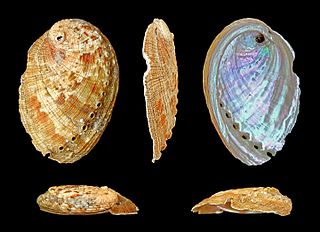
Abalone is a common name for any small to very large marine gastropod mollusc in the family Haliotidae, which once contained six genera but now contains only one genus, Haliotis. Other common names are ear shells, sea ears, and, now rarely, muttonfish or muttonshells in parts of Australia, ormer in the United Kingdom, perlemoen in South Africa, and pāua in New Zealand. The number of abalone species recognized worldwide ranges between 30 and 130 with over 230 species-level taxa described. The most comprehensive treatment of the family considers 56 species valid, with 18 additional subspecies.

The Asian parti-colored bat is a species of parti-coloured bat. An adult Asian parti-colored bat has a body length of 6–7 cm (2.4–2.8 in), a tail of 4.3–4.5 cm (1.7–1.8 in), and a wing length of 5 cm (2.0 in). Asian parti-colored bats are distributed across East Asia, from Taiwan through eastern China, eastern Mongolia and Russia (Siberia) to the Korean Peninsula and Japan.

The Ryukyu minivet is a species of bird in the family Campephagidae. It is endemic to Japan. The species was previously thought to be a subspecies of the ashy minivet. Its specific name is named for the Japanese naturalist Seiichi Tegima.

The green ormer is a northeast Atlantic and Mediterranean species of sea snail, a coastal marine gastropod mollusc in the family Haliotidae, the abalone or ormer snails.

The blacklip abalone, Haliotis rubra, is an Australian species of large, edible sea snail, a marine gastropod mollusk in the family Haliotidae, the abalone.

Haliotis gigantea, common name the giant abalone, is a species of sea snail, a marine gastropod mollusk in the family Haliotidae, the abalone. It is also known as Siebold's abalone, after Philipp Franz von Siebold.

Haliotis diversicolor, common name the variously coloured abalone, is a species of sea snail, a marine gastropod mollusk in the family Haliotidae, the abalone.

Haliotis elegans, common name the elegant abalone, is a species of sea snail, a marine gastropod mollusk in the family Haliotidae, the abalone.

Haliotis fulgens, commonly called the green abalone, is a species of large sea snail, a marine gastropod mollusc in the family Haliotidae, the abalone. The shell of this species is usually brown, and is marked with many low, flat-topped ribs which run parallel to the five to seven open respiratory pores that are elevated above the shell's surface. The inside of the shell is an iridescent blue and green.

Haliotis jacnensis, common name Jacna abalone, is a species of sea snail, a marine gastropod mollusk in the family Haliotidae, the abalone.

Haliotis madaka is a species of sea snail, a marine gastropod mollusk in the family Haliotidae, the abalone.

Haliotis rubiginosa, common name the Lord Howe abalone, is a species of sea snail, a marine gastropod mollusk in the family Haliotidae, the abalone.

Haliotis rugosa, common name the many-holed abalone, is a species of sea snail, a marine gastropod mollusk in the family Haliotidae, the abalone.

Haliotis semiplicata, common name the semiplicate abalone, is a species of sea snail, a marine gastropod mollusk in the family Haliotidae, the abalone.

Haliotis stomatiaeformis is a species of sea snail, a marine gastropod mollusc in the family Haliotidae, the abalones. It is endemic to a small portion of the Mediterranean Sea, off the coasts of Sicily and Malta.

Haliotis clathrata, common name the lovely abalone, is a species of sea snail, a marine gastropod mollusc in the family Haliotidae, the abalone.

Haliotis varia, common name the variable abalone or the common ear shell, is a species of sea snail, a marine gastropod mollusk in the family Haliotidae, the abalones.

Haliotis, common name abalone, is the only genus in the family Haliotidae.
Pseudoruegeria haliotis is a Gram-negative, rod-shaped, aerobic and non-motile bacterium from the genus of Pseudoruegeria which has been isolated from the gut of an abalone from the coast of Jeju Island in Korea.
Tenacibaculum haliotis is a bacterium from the genus of Tenacibaculum which has been isolated from the gut of an abalone from the sea near Jeju island in Korea.




















